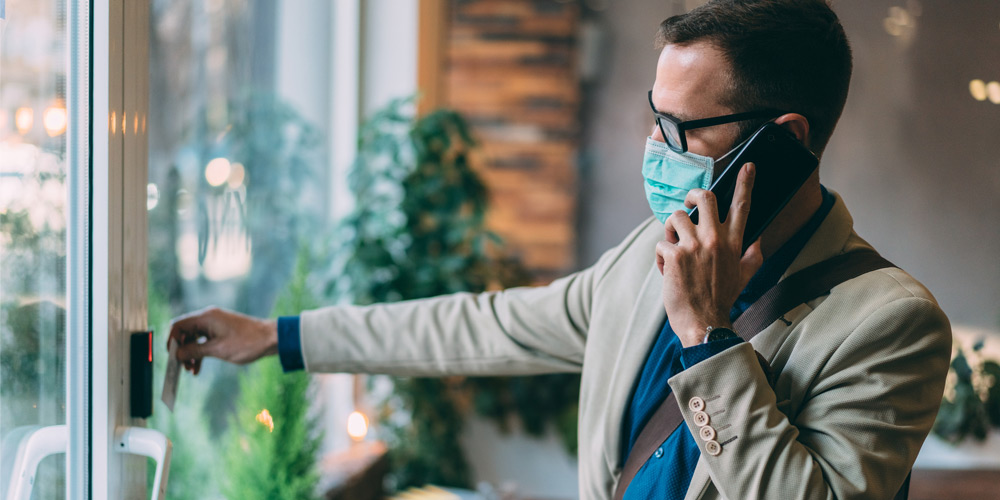Checking in on employee health and well-being
Automatic contact tracing in the workplace can help protect employees from COVID-19 while preserving personal privacy.
The coronavirus has brought many changes to the workplace, and to the relationship between employers and employees.
As companies focus on helping their workforce adjust to working from home, they are beginning to understand and overcome the barriers faced in doing so. And they’re having to gather more information — and communicate more regularly — about employees’ health, whereabouts, and movements. In this new normal, companies will need to use technology to keep in touch with their workforces and understand their ability to stay productive and healthy whether they are working at home or at the office. In a PwC survey conducted during the week of April 20, 37 percent of CFOs around the world said they believe they will see a loss of productivity over the next month due to remote work. In a survey two weeks earlier, 45 percent of respondents anticipated this issue.
Many of the tools that may have been effective before COVID-19 for staying in touch and helping people — email blasts, daily stand-up calls, help desks, troubleshooting, chat groups, company-wide text updates — aren’t up to the task. As of April 16, just 28 percent of organizations had a process or system in place to keep track of all of their people, according to PwC’s COVID-19 Navigator (an assessment of crisis preparedness based on responses of more than 1,000 corporate leaders). It is clear that companies will need more effective and up-to-date measures to keep those on-site more protected, and eventually help them feel comfortable and confident coming back into the workplace — all while respecting their privacy and complying with regulations. The solution lies in technology that helps companies stay connected to the workforce and provide a near-real-time view of people’s ability to work each day.
First, companies can use a simple Web-based application to answer a basic question: Are your people able to work, regardless of where they are? Sure, companies can measure calls to the IT help desk or application outages and estimate (or guess) what percentage of people are fully online and engaged. But companies need to know, at a granular level, how many people can work effectively in the business unit to which they belong.
Many companies are relying on information that trickles in via hindsight or long email chains. If the risk management division in New York City is having trouble working from home for any reason, how would the company know? Emails or calls to the help desk would start to pile up. An internal customer might complain about not getting a response. At some point, someone realizes most of the team can’t work effectively. Hours, perhaps even days, have passed by the time the company fully recognizes an issue, and understands how broad it is and who else might be impacted or how to mitigate the problem. The result: frustrated people, critical work left undone, and new stressors in an already stressful work environment — not to mention potential impact to the bottom line.
Once companies have a handle on who is able to work at any given time, they can determine which of those people are able to work productively in their new setups. And if not, why not? The issue might be personal, such as an ineffective home office setup, a lack of childcare, or the need to take care of an ailing family member. Or it could be systemic, and thus within the company’s control — a poorly functioning network, a breakdown in communications, or a bug in a crucial app or piece of software. Perhaps the sales servicing unit in Minnesota is experiencing an application error or Internet instability and can’t service clients, but the same unit in Wisconsin is operating without issues. For many companies, there’s no way to know quickly, so no one realizes they need to take action.
The key to dealing with such issues is to stop gathering anecdotes and to start gathering and assessing data through an app or dashboard. A simple, Web-based tool like PwC’s Check-In enables just that: It lets people check in daily, report their status, and flag issues. Leaders get a near-real-time look at what percentage of their people (employees, contractors, and anyone else they designate) can work effectively, and what the problems are when they can’t. A live dashboard shows locations, business units, and status in real time. As a result, companies can identify trouble spots and move quickly to help their people and their customers.
It is unclear when — or if — all offices or places of business will reopen. But as people return to offices, buildings, factories, or stores, it is vital that they can do so with confidence. Ensuring a low-risk environment in which to work and accurate, efficient ways to identify people who are at risk of infection are necessary to build trust and assuredness as we claw our way back to normalcy.
To date, most of the approaches used by companies have been blunt instruments: If a person at a facility is diagnosed with COVID-19, an email goes out to the whole company, the facility or office is shut down, and the entire team is sent home to quarantine. Even with badge-tracking data or personal interviews, companies can only guess at the potential contacts the employee had with colleagues.
Moving forward, it is clear that a comparatively old technology — contact tracing — will be crucial. Contact tracing, or identifying people who may have come into contact with infected people, was used in the 1918 Spanish flu pandemic. The World Health Organization and most public health officials advocate contact tracing as a way to reduce risk and assess safer return to physical workplaces. States in the U.S., including Massachusetts, have begun to develop their own version, only using an army of people to do the tracing. Apple and Google teamed up to create a system anyone with one of their smartphones could use for contact tracing.
Contact tracing will likely be a common practice in managing the risk of working and living in a world in which a vaccine has yet to be developed and testing protocols are still not ramped up. And although, in the week of April 20, only 21 percent of CFOs said their company was considering contact tracing measures, that number is likely to rise. As we enter a phase of returning to workplaces, it’s crucial for companies to take on the responsibility themselves and implement an enterprise-level approach to automatic contact tracing within the confines of a work site.
As we enter a phase of returning to workplaces, it’s crucial for companies to implement an enterprise-level approach to automatic contact tracing within the confines of a work site.
With Check-In, PwC has developed one such approach. Check-In’s automatic contact tracing function was developed as a company-level solution that makes identification of those at risk much faster and still puts privacy first, tracing contact only within a workplace. Since such efforts inevitably — and rightly — raise concerns about privacy, spoofing, and overreach, it bears repeating: Check-In’s Automatic Contact Tracing tracks movements only within the physical space of the office or business facility.
Here’s how automatic contact tracing works. Employees download an app and enter their name, email, or other identifier. Their phone or device serves as a signal, called a beacon, that tracks where in the workplace it goes. Employees go about their days, with their phones pinging off other devices, noting how long one device is near another. The data transmitted is stored anonymously and is used to identify a person only if they need to be notified of a risk. When an employee reports she’s contracted COVID-19, an authorized user — usually in HR — can quickly get a list of which of her colleagues’ beacons were close enough to present a heightened risk or exposure, and whether the proximity correlation is high, medium, or low. Companies can thus act swiftly and precisely to inform and protect people without causing undue panic or sending entire teams home. Once the data is used, it is purged from the dashboard to help preserve privacy and anonymity.
Technology is not a perfect substitute for direct human contact and presence. But we have already seen the rapid development and deployment of technologies that can enable colleagues, customers, friends, and family to connect in new ways, from virtual jam sessions to live video happy hours to virtual birthday celebrations.
As we continue to adjust to a new normal, and prepare to take steps to return to school, to work, and to life, it is vital that we harness the power of technology to mitigate risks to employee health and business operations. Business leaders must figure out how to check in on people in a helpful, unobtrusive way that will build confidence, boost trust, and give leaders the insight needed to make the right decisions.






